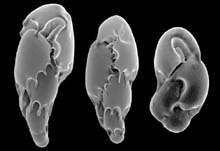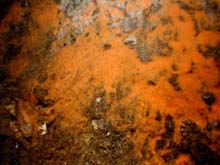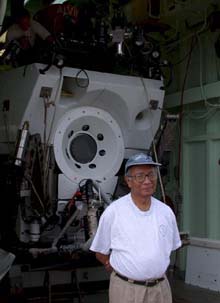
A scanning electron micrograph of single-celled foraminifera collected from the deep sea off Venezuela. Initial examination of this species indicates that it has made interesting and novel adaptations to live in a "hostile" environment. Click image for larger view.
The Huge Role Played by Tiny Creatures of the Deep
September 24, 2001
Paula Keener-Chavis, Director
South Carolina Statewide Systemic Initiative's Charleston Math and Science Hub
Deep East Education Project Coordinator
The woods call to us with a hundred voices, but the sea has one only -- a mighty voice that drowns our souls in its majestic music. The woods are human, but the sea is of the company of the archangels.
--L.M. Montgomery, Anne’s House of Dreams
Benthic foraminifera are single-celled organisms collectively referred to as a unique assemblage of animals known as the "protista." Along with the bacteria, they are some of the most common life forms on Earth. They are also ubiquitous, with both freshwater and terrestrial forms recently identified.
Dr. Joan Bernhard, research professor in environmental health sciences at the University
of South Carolina, is participating in this leg of Deep East to collect benthic forams associated with bacterial mats found on Blake Ridge. She is studying forams that secrete a calcareous test, or shell-like structure, around themselves. "It is really difficult to tell if the forams are alive or dead when they are collected, because cytoplasm can remain in tests for quite some time after the individual dies. In fact, research has shown that in deep-sea environments, the cytoplasm can remain in the test for several years," she notes. Dr. Bernhard uses transmission electron microscopy to look for organelles, such as mitochondria and Golgi bodies, in the cells' "ultrastructure."

Orange-colored bacterial mats inhabit oil and gas seeps throughout the Gulf of Mexico. Forams are commonly found in these mats. Click image for larger view.
Dr. Berhard recently discovered that some fof these single-celled organisms host endosymbionts, such as bacteria, that reside with the forams' own cytoplasm. She published these findings last year in Nature magazine; her discovery of live forams at cold seeps in Monterey Bay, off California, were published last month in the scientific journal Deep Sea Research.
Still other deep-sea forams have been shown to incorporate chloroplasts from diatoms into
their cytoplasm. The forams ingest the chloroplasts and appear to be quite selective about the diatoms upon which they choose to "dine." Some scientists think that the forams' pseudopods (false feet) pry open the diatoms' tests to gain access to their chloroplasts. One theory is that deep-sea photosynthesis may be taking place within the forams, but because the chloroplasts are randomly distributed throughout the forams' cytoplasm and not clustered near the surface of their tests (potentially closer to a light source), this theory may not be entirely correct.
The first definitively live forams to be collected at cold seeps were found in Monterey Bay. To date, the forams collected from Gulf of Mexico seeps that Dr. Bernhard has examined were all found to be dead, apparently for a long period of time. Scientists are investigating differences between these two environments in an attempt to answer why a cold-seep community in Monterey Bay might be a more favorable environment to a foram than a similar cold-seep community in the Gulf of Mexico. The scientists on the Atlantis are curious to see if we uncover new information about forams associated with methane-hydrate seeps on Blake Ridge.
"We don’t know if we will find anything new out here, but just trying to answer that question is part of my fascination with forams, and their bizarre adaptations that enable them to survive in extreme environments of the deep sea," Dr. Berhard concludes.

Dr. Barun Sen Gupta stands in front of the Alvin manned submersible aboard its mother ship, the R/V Atlantis. Click image for larger view.
Interview with Dr. Barun Sen Gupta
Henry V. Howe Professor of Geology
Louisiana State University
Ocean Exploration Team: What are your exploration interests on the Deep East Expedition?
Dr. Sen Gupta: I'm studying forams from a geological perspective. I'm interested in looking at the forams that are present at the sediment-water interface, and at the forams living within the sediments, which are called endobenthic forams. Forams have been used for well over 100 yrs to determine the age of rocks and how the rocks were formed. From the sediment core samples collected by Alvin, I will be able to determine the distribution of shells throughout the core. Using carbon-14 isotope dating on the foram shells and/or carbonate nodules, I should be able to track the history of methane venting on the Blake Ridge.
Ocean Exploration Team: As a researcher and professor of geology, what is your perspective of the expedition?
Dr. Sen Gupta: I would say that the present exploration is an interdisciplinary perspective that focuses on both the biological and geological aspects of gas hydrates' escape into the marine environment. I am primarily a paleontologist, and the expedition offers a very special opportunity to interact with extremely competent scientists whose interests are by no means identical to mine, but overlap nevertheless.
Ocean Exploration Team: What and/or who influenced your decision to pursue a career in ocean science?
Dr. Sen Gupta: It was a historical development in my career. For about the first 6 yrs after getting my PhD, my research focused entirely on 50-million-yr-old marine fossils that I found in land outcrops. This early research led me to questions related to environments sustaining modern benthic foraminifera. The opportunity came when I went to Canada's Bedford Institute of Oceanography to investigate forams living on the Grand Banks. Thus, the inspiration to get involved in ocean-science research came from colleagues, and not from a specific mentor.
Ocean Exploration Team:What do you expect to find at the site?
Dr. Sen Gupta: Beautifully preserved marine sediments that record the history of a very special, but perhaps changing, environment.
Sign up for the Ocean Explorer E-mail Update List.
































